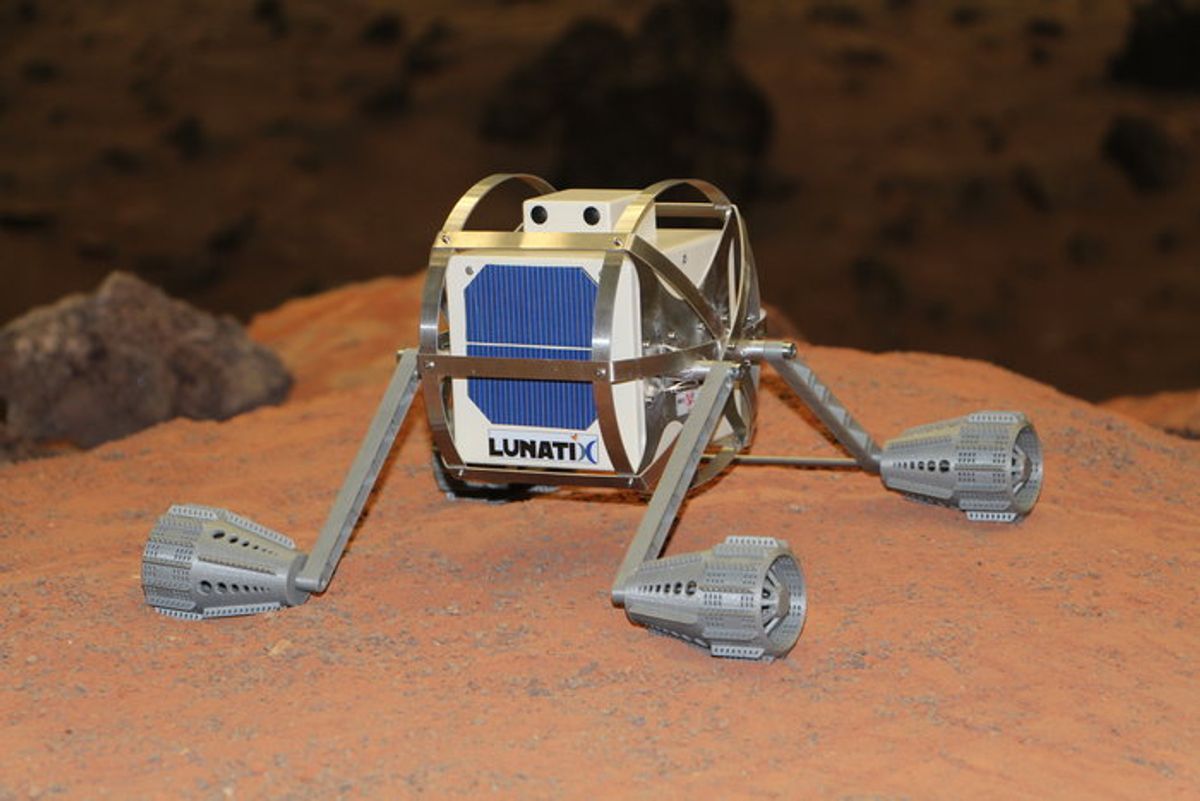The moon isn't nearly as exciting as it used to be. Once we convinced ourselves that it was mostly just a big dead pile of rock (which didn't take long), interest and the funding that comes with it moved to Mars and beyond. The biggest thing that the moon has going for it is that it's relatively close to us: Spacecraft can get there in just a few days, and it takes only a couple of seconds for a signal to get there from here.
The European Space Agency has been trying to encourage a hybrid approach to lunar usefulness, combining science with business (like mining and tourism) to help promote exploration in general. In partnership with the SpaceTech program at the Graz University of Technology in Austria, ESA is encouraging startups to develop ways of making money on the moon. One of the most recent ideas involves a bunch of little robots that gamers will be able to drive themselves.
Lunatix, as this new company is called (get it?), sees the surface of the moon as the next great opportunity for augmented reality gaming. They want to send a team of robots to the surface by 2021, including five small (1.5kg) Nanobots that gamers will be able to drive directly, along with a larger (150kg) mothership that will provide support (power and communications) to the smaller robots, and also house a token science payload.

The MMP [Main Mobile Platform] will have four wheels with a 4x4 drive and an independent suspension of each wheel. The wheels will have hub electro-motors with gearboxes directly attached. The wheels will be made of wired mesh, similar to the design of the ones used in the Apollo Programme. Their main advantages are low weight, good traction, and excellent suspension properties. The MMP will be able to move up to 20 km/h.
The Nanobots will also have 4 wheels, but with a 2x2 drive of hub electro-motors. The Nanobots will be able to reach up to 5 km/h. They will be also capable of hopping, using their suspension systems as catapults. The low-gravity lunar environment will allow hopping up to 3 meters in the air and broad jumps of 10 meters in a single bound. Due to the spherical shape of their cages, the Nanobots will have no problems recovering after landing and taking off again.
Lunatix is projecting that they'll make an amount of money equivalent to what Angry Birds Space made. That is, something like €300 million ($353 million) over seven years. Of that, they predict about one-third will come from merchandising, and half from subscriptions. Lunatix says it is expecting 60 million page views per month on its website—several years before the robots are even launched to the moon. Most users, Lunatix says, will be paying €2 per month for a subscription to the games that will include, uh, the ability to drive virtual rovers around a virtual lunar surface. Yay?
The game will allow controlling a virtual Nanobot in a simulated Moon environment. It will be free of charge during this phase. Once the Nanobots are deployed on the lunar surface, the game will be enhanced with real images and videos from the Moon. Given the enormous success of the game “Pokemon Go!”, the game powered by Lunatix will also include Augmented Reality techniques. Revenues will be made by monthly subscriptions to the game and by selling to gamers timeslots with the possibility to control the real Nanobots on the actual Moon.
To get what gamers really want, which is the ability to drive a real rover on the real lunar surface, Lunatix is expecting users to pay €500 ($590) for a 20-minute time slot. Players can also win the experience as an in-game prize, but the amount of time and effort it would take to do that, Lunatix says, implies that those users will have “already spent a significant amount of time and money in subscription fees.” And if you want to drive a rover without having to buy a time slot or wait in line? “The full ownership of one of the five Nanobots will be sold to one exclusive user through an auction starting at €15 million [$17.7 million].” Lunatix helpfully notes that this is only half the cost of spending a week on the ISS yourself, but I feel like a week in space might be more than twice as cool, especially since even your own personal Nanobot won't be able to stray very far from its mothership, and also won't work half the time when it's nighttime on the moon.
While there's a small section in the Lunatix executive summary on “Legal Framework,” there are few specifics about whether or not the United Nations would approve something like this. Lunatix seems to suggest that its use case is covered under “the common interest of all mankind in the progress of the exploration and use of outer space for peaceful purposes,” but I'm not so sure. It may be that no framework exists yet (either for or against), and my gut reaction that commercializing the moon in this way somehow cheapens it is probably just me being old and grumpy. If this is the best way to get robots to the moon, then so be it.
[ Lunatix (PDF) ] via [ ESA ]
Evan Ackerman is a senior editor at IEEE Spectrum. Since 2007, he has written over 6,000 articles on robotics and technology. He has a degree in Martian geology and is excellent at playing bagpipes.



